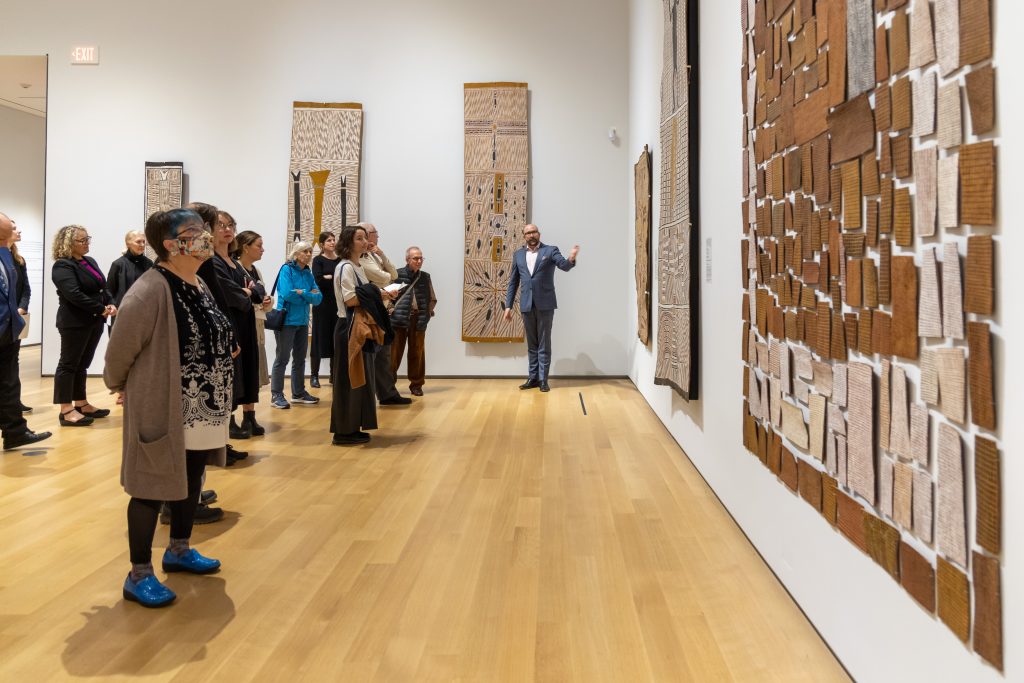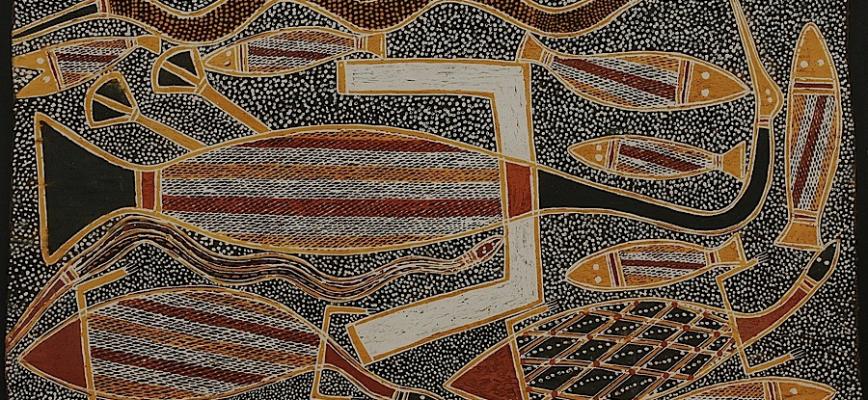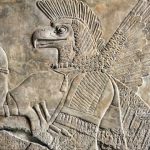Australian Aboriginal art, celebrated globally for its distinct dot paintings, represents the indigenous people of Australia, and their rich cultural legacy. Aboriginal cultures, which consist of around 400 separate inner communities, each with their own language, sets of customs, music and art practices, have produced an aesthetically marvelous art form that serves a dual function.
Beyond the obvious visual appeal, the elaborate dot designs and cross-hatching methods are more then mere decoration; encapsulating profound, mystical and spiritual significance. Hence, these creative techniques, skillfully devised to conceal the sacred stories and symbolism underlying each painting, providing a look into the profound spiritual and cultural components of Aboriginal existence.
Early Roots of Australian Aboriginal Dot Paintings
An essential element of Aboriginal Australian art and its evolution; dot painting, with a historical time line that stretches way back to ancient times; with an estimate of 40,000 years of archeological proofs. Furthermore, Aboriginal dot painting initially served both aesthetic and utilitarian purposes, including the concealment of sacred symbols from uninitiated observants.
Dot painting, additionally used ceremonially in body painting and sand art, in which it stood for deeper spiritual associations and ties to the “Dreamtime“; which is the Aboriginal perception of the universe, its inception, mythical narratives and stories around its historical timeline and origins of existence. Contemporary Aboriginal artists have adapted dot painting to maintain traditional values while sharing and preserving their culture.

Early Aboriginal Paintings, Types and Their Cultural Significance
Initiating The Contemporary Movement (Papunya Tula, 1971 onwards)
Aboriginal artists in the region began transferring traditional desert art to canvases and boards, initiating momentum of what will later be contemporary dot painting movement. They leveraged dots to conceal sacred elements, ensuring the stories remained protected.
Creating Rock Art in The Kimberley
Aboriginal painters have been producing rock art, such as the Wandjina and Gwion figures, in the Kimberley area of western Australia for as long as 40,000 years. some of these artworks include dotting techniques to symbolize and stress on notion such as rain, spirit, and energy fields.
Using Dots in Ceremonial Body and Sand Art
Aboriginal people have applied dots in ceremonial body painting and sand art for thousands of years. Nevertheless, These artworks, each crafted exclusively a specific ceremony, aimed to connect the community with ancestral beings and the land, with dots symbolizing natural and spiritual elements.
Incorporating Dots in Arnhem Land Bark Paintings
Artists in Arnhem land have been incorporating dots into their bark paintings for over 50,000 years. Additionally these paintings, which often narrate ‘Dreamtime’ stories, use dots among other techniques to express the spiritual and cultural depth of Aboriginal lore.

Internationally Renowned Aboriginal Painters
- 1.Clifford Possum Tjapaltjarri (1932-2002)
Famous Works and Market Value: “Warlugulong” (1977) and “Man’s Love Story” (1978). Clifford’s painting “Warlugulong” sold for over AU$2.4 million in 2007, setting a record for Aboriginal art at the time.
Symbolism and Meaning: Clifford’s work often explores themes such as Dreamtime stories, ancestral tracks, and the relationship between people, animals and the land.
- 2.Emily Kame Kngwarreye (1910-1996)
Famous works and Market Value: “Earth’s Creation” (1994) and “Big Yam Dreaming” (1995), with “Earth’s Creation” fetching over AU$2 million at auction in 2017, thus, highlighting her status as one of Australia’s most significant contemporary artists.
Symbolism and Meaning: Emily’s creation, deeply connected to her cultural heritage and land, with her works reflecting the life cycle of the yam plant, an essential food source, and above all, a symbol in her community.
- 3. Johnny Warangkula Tjupurrula (1925-2001)
Famous Works and Market Value: “Water Dreaming at Kalipinypa” (1972) selling for over AU$486,000 in 2000. And “Tingari Cycle”, his works have fetched hundreds of thousands of dollars internationally.
Symbolism and Meaning : Johnny’s work, well known for its complex interplay of elements such as dots, lines, and circles, representing water sources, rain, and the ancestral journeys of the Tingari; Spiritual beings central to his cultural mythology.
- 4. Minnie Pwerle (1910-2006)
Famous Works and Market Value: “Awelye Atnwengerrp” (2000) and “Bush Melon” (2005). Her paintings have sold for up to AU$504,000 at auction, Hence, marking herself as one of the prominent female Aboriginal artists
Symbolism and Meaning : Minnie known works, marked by bold colors and dynamic dot patterns that celebrate the women’s ceremonies and dreamtime stories of her Atnwengerrp origins.
In a nutshell, Aboriginal painting and art at large offers a window into the essence of Australian culture, blending ancient traditions with contemporary expressions to share a rich cultural legacy.







